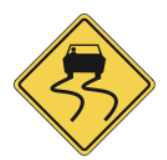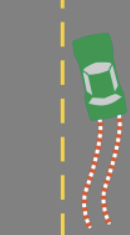Session 22 – Adjusting Speed
ADJUSTING SPEED
The faster your vehicle is going, the more distance it will take to turn, slow or stop. For example, stopping at 60 mph does not take twice the distance it takes at 30 mph, as one might think. It takes over three times the distance! Driving safely means obeying speed limits, but adjusting your speed for road and traffic conditions, and how well you can see.
Adjusting To Road Conditions
There are various road conditions where, to be safe, you need to slow down. For example, slow down before a sharp curve, when the roadway is slippery or when there is standing water on the road.
The only contact your vehicle has with the road is through the tires. How good the tires grip the road depends on the type and condition of the tires, and the type and condition of the road surface.
Many drivers do not pay enough attention to the condition of their tires or to the condition of the roadway. It is important that your tires be in good condition and have enough air in them. See your vehicle owner’s manual for correct tire pressure.
Your tires do not have as much traction on gravel or dirt roads as they do on concrete or asphalt roads. When driving on gravel or dirt, you need to slow down. It will take you much longer to stop on gravel or dirt and it is much easier to skid when turning.
Curves: A vehicle can travel much faster in a straight line than it can in a curve. It is easy to go too fast in a curve. If you go too fast, the tires will not be able to grip the road and your vehicle will skid. Always slow down before you enter a curve so you do not have to brake while in the curve. Braking in a curve can cause your vehicle to skid.

Slippery roads: Slow down at the first sign of rain, snow, or sleet. All of these make the roadway slippery. When the road is slippery,
your vehicle’s tires do not grip as well as they do on a dry road. How slow should you go? On a wet road, you should reduce your speed about 10 mph. On packed snow, you should cut your speed in half. On ice, you must slow to a crawl. It is very dangerous to drive on ice.
If at all possible, do not drive when the roads are icy
Some road surfaces are slippery at certain times or places. Here are some clues to help you spot slippery roads:
- Shady spots can be icy on cold, wet days. These areas freeze first and dry out last.
- Overpasses and other types of bridges can have icy spots, even when other pavement is not icy. This is because bridges do not have earth underneath them to help insulate them against the cold so they freeze sooner than other roadways.
- When the temperature is around the freezing point, ice can become wet. This makes it more slippery than at colder temperatures.
- If it starts to rain on a hot day, the pavement can be very slippery for a while. Heat causes the oil in the asphalt to come to the surface. The road is more slippery until the oil is washed off.

Water on the roadway: When it is raining or the road is wet, most tires have good traction up to about 35 mph. However as you go faster, your tires will start to ride up on the water, like water skis. This is called “hydroplaning.” In a heavy rain, your tires can lose all traction with the road at about 50 mph. Wide tires or tires that are bald or badly worn will lose traction at much lower speeds.
The best way to keep from hydroplaning is to slow down in the rain or when the road is wet.
If it feels like your tires have lost traction with the surface of the road, you should:
- ease your foot off the gas pedal.
- keep the wheels straight. Only try to turn if it’s an emergency. If you must turn, do it slowly, or your vehicle may skid.
- do not try to stop or turn until your tires are gripping the road again.
